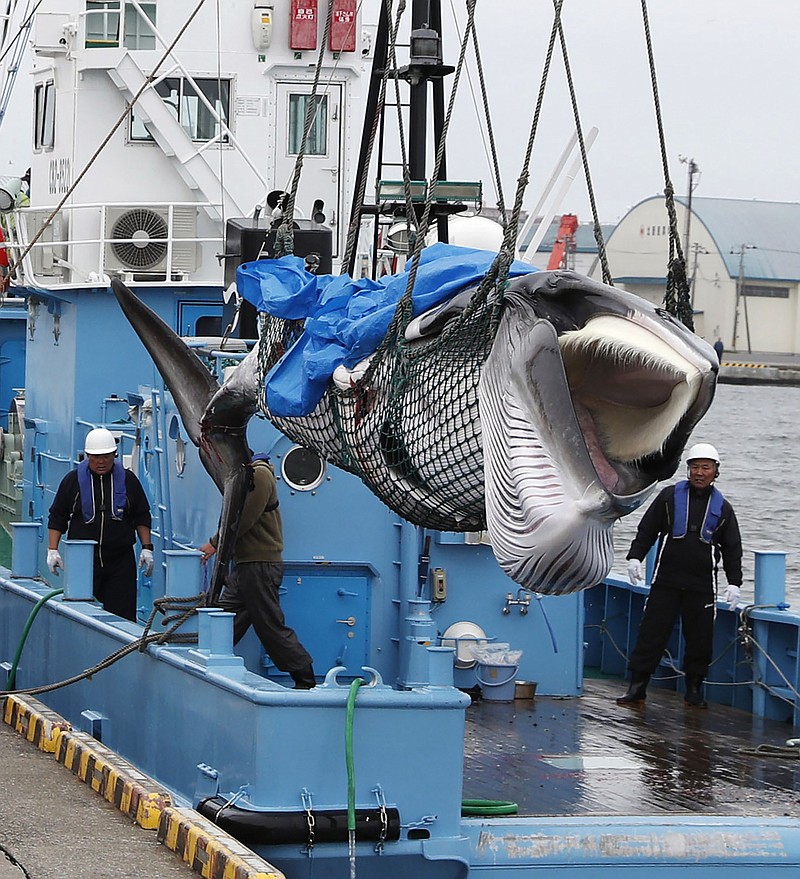TOKYO (AP) - Japanese whalers returned to port Monday with their first catch after resuming commercial whaling for the first time in 31 years, achieving the long-cherished goal of traditionalists that is seen as largely a lost cause amid slowing demand for the meat and changing views on conservation.
A fleet of five boats left the northern Japanese port of Kushiro earlier Monday and brought back two minke whales. A crane lifted them and slowly placed them on the back of a truck to be taken to a portside factory for processing. Workers in blue plastic overalls poured sake from paper cups onto the first whale to express thanks and celebrate the first catch.
It was the first commercial hunt since 1988, when Japan switched to what it called research whaling after commercial whaling was banned by the International Whaling Commission. Japan gave six months' notice that it was withdrawing from the IWC, a move that took effect Sunday.
The Fisheries Agency said the hunts will stay within the country's exclusive economic zone, and the catch quota for the rest of this year will be 227 whales, fewer than the 637 Japan hunted in the Antarctic and the northwestern Pacific in its research program in recent years. The announcement of the quota, originally planned for late June, was delayed until Monday in an apparent move to avoid criticism during this past weekend's G-20 summit in Osaka.
As the boats left port, whalers, their families and local officials in two major whaling towns, Shimonoseki in southwestern Japan and Kushiro in the north, celebrated the fresh start, hoping for their safe return and a good catch. Shimonoseki is Prime Minister Shinzo Abe's electoral constituency.
"We hope commercial whaling will be on track as soon as possible, contribute to local prosperity and carry on Japan's rich whale culture to the next generation," Deputy Chief Cabinet Secretary Yasutoshi Nishimura told reporters in Tokyo.
Officials said the catch of the two minke whales was a nice surprise because they were not thought to be in the area, and whalers were expecting Monday's trip to be only ceremonial.
Fisheries Agency officials said the whale meat will be auctioned at a local fish market Thursday and later hit stores, mainly in the region but possibly in Tokyo. Whalers are hoping for a special price for the historic meat that is higher than the average $18 per 2.2 pounds their counterparts from Antarctic research whaling used to get.
While the resumption of commercial whaling was condemned by many conservation groups, others see it as a face-saving way to let the government's embattled and expensive whaling program gradually succumb to changing times and tastes.
Despite massive attention, tax money and political support from ruling party lawmakers, whaling in Japan involved only a few hundred people and accounted for less than 0.1 percent of the total meat consumption in fiscal 2017, according to government data.
Whale meat was an affordable source of protein during the lean times after World War II, with annual consumption peaking at 223,000 tons in 1962. However, whale was quickly replaced by other meats. The supply of whale meat fell to 6,000 tons in 1986, the year before the moratorium on commercial whaling imposed by the IWC banned the hunting of several whale species.
Under its research whaling, which was criticized as a cover for commercial hunts because the meat was sold on the market, Japan caught as many as 1,200 whales a year. It drastically cut back its catch in recent years after international protests escalated and whale meat consumption slumped at home.
Today, 4,000-5,000 tons are supplied in Japan annually, or 1-1.4 ounces of whale meat per person a year, Fisheries Agency officials said.
The research whaling program lost money for years - $15 million in the last year alone.
Japan will stick to a very strict catch quota and will continue conducting research, Hideki Moronuki, a Fisheries Agency official and the chief negotiator at the IWC, said in a recent interview. He said Japan's commercial whaling will never harm whale stocks.
The commercial whaling will be carried out by two groups. The mother factory ship Nisshin-maru and two support boats that used to go to the Antarctic will travel as far as Japan's 200 nautical mile exclusive economic zone to catch minke, Bryde's and sei whales. Five other smaller ships will stay closer to the coast but also hunt minkes, in addition to 168 Baird's beaked and two other kinds of small whales they used to catch outside of IWC jurisdiction. Altogether, they are to catch 52 minkes, 150 Bryde's and 25 sei whales through Dec. 31.

